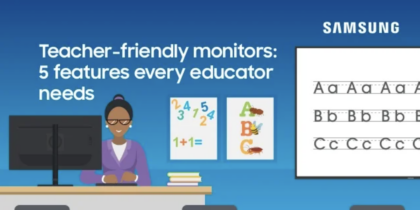The next generation of learners will forge ahead in the Science, Technology, Engineering and Math (STEM) fields. These skills are a central element of a well-rounded education; however, STEM education should not be an isolated entity. Many institutions don’t look for opportunities to weave science and technology into other coursework when they should. In fact, results from a 2015 GfK Knowledge Panel survey of K-12 teachers nationwide, revealed that approximately half of the respondents dedicated only 10 percent or less time to STEM coursework, or didn’t know what STEM was at all. Education is multi-dimensional, and educators should work to de-compartmentalize science, mathematics and technology from other subjects.
With only 16 percent of American high school seniors proficient in mathematics and interested in a STEM career, according to the U.S. Department of Education; institutions need to get away from the mindset that ‘you’re either STEM, or you’re not,’ and embrace a holistic approach to instruction that weaves STEM elements into other coursework and subjects. There should be a constant stream of STEM influence in students’ daily curriculum.
Take a Holistic Approach
We should encourage students to think holistically about their interests. The way we keep students interested in STEM is to make STEM available to all students, regardless of their interests and strengths in the classroom. If a student is musically inclined, they are just as entitled to a math and science foundation to enhance their music abilities. The University of Florida found that art education can improve overall academic performance. In fact, students who took up music appreciation scored 61 points higher on the verbal section and 42 points higher on the math section of the SAT. Studies suggest that if a student excels at music, there is higher probability they will excel at math.
Educators should choose an area of interest and learn the mathematical framework of that area. It could be a musician who wants to learn harmonics – even the audible sounds in our mobile technology have a lot of grounding in the STEM space and in creativity.
STEM Education Opportunities for Tomorrow
We’ve found that young girls reach a critical decision on whether they will pursue the sciences by the fourth and fifth grades. To encourage girls at this critical time, Samsung has developed an after-school and summer program called emPOWER Tomorrow designed to introduce girls to the people, technologies and processes behind the software and hardware they use in their everyday lives. Throughout the program, students are introduced to computer science and electrical engineering concepts in a safe, fun and hands-on learning environment. Students also meet real-life scientists and engineers from Samsung and explore career possibilities in the STEM industry.
To excite all students about the possibilities of STEM education, Samsung has also started the Solve for Tomorrow education contest, giving teachers across the U.S. the opportunity to raise students’ interest in STEM subjects by awarding their schools with a share of over $2 million in technology products. The contest challenges teachers to use STEM creativity to solve a problem within their community. This opportunity specifically addresses the technology gap that exists in many classrooms across the country today.
After recently being named one of the 100 CIO/CTO leaders in STEM by STEM Connector, I think it’s imperative to encourage students to explore the possibilities in the STEM field. Somehow or another we’ve got to think about STEM in a holistic way. There isn’t a separation, there is collusion. This is why at Samsung we’ve made it our mission to raise student interest in STEM subjects nationwide through innovative programs with our partners that will help us all build a better tomorrow.







